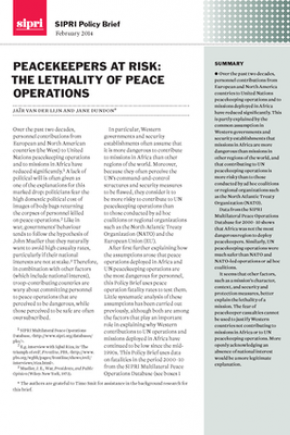The independent resource on global security
Peacekeepers at Risk: The Lethality of Peace Operations
Over the past two decades, personnel contributions from European and North America countries to United Nations peacekeeping operations and to missions deployed in Africa have reduced significantly. This is partly explained by the common assumption in Western governments and security establishments that missions in Africa are more dangerous than missions in other regions of the world, and that contributing to UN peacekeeping operations is more risky than to those conducted by ad hoc coalitions or regional organizations such as the North Atlantic Treaty Organization (NATO).
Data from the SIPRI Multilateral Peace Operations Database for 2000–2010 shows that Africa was not the most dangerous region to deploy peacekeepers. Similarly, UN peacekeeping operations were much safer than NATO and NATO-led operations or ad hoc coalitions.
It seems that other factors, such as a mission’s character, context, and security and protection measures, better explain the lethality of a mission. The fear of peacekeeper casualties cannot be used to justify Western countries not contributing to missions in Africa or to UN peacekeeping operations. More openly acknowledging an absence of national interest would be a more legitimate explanation.


